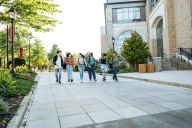You have /5 articles left.
Sign up for a free account or log in.

Three in five college students struggled with food insecurity in the past 30 days or with housing insecurity in the past 12 months, according to data from Temple University’s Hope Center for Student Basic Needs.
xavierarnau/E+/Getty Images
Despite a growing national focus on student basic needs insecurity and its impact on retention and completion, a majority of learners in need have not accessed public benefits or resources from their college or university to address deficiencies.
The Hope Center at Temple University’s latest student basic needs survey found just under three in five students (59 percent) experienced at least one form of basic needs insecurity related to food or housing in the past year. This number grows to 73 percent of respondents when the definition is expanded to include mental health care, childcare, transportation or internet and technology access.
Among these students who did report at least one current basic needs insecurity, over half said they didn’t receive state or federal resources to address these concerns, and 48 percent didn’t engage with campus services or resources, either.
The background: The Hope Center’s Student Basic Needs Survey, previously called the #RealCollege survey, is a snapshot of a national challenge impacting student retention and completion. While the survey is not nationally representative, it provides regular data with an expanded definition of basic needs insecurity that can inform practice and policies, according to report authors.
Starting in March 2020, the federal government has collected nationally representative data on food insecurity and homelessness as part of the National Postsecondary Student Aid Survey. Federal data found one in four undergrads and one in eight graduate students were experiencing food insecurity, for a total of 4.3 million students. An additional 1.5 million students experienced homelessness.
Methodology
The report includes data from 91 colleges and universities across 16 states that participated in the Hope Center Student Basic Needs Survey between spring 2023 and summer 2024. Responses include 74,350 students who responded to the survey, with 53,978 from two-year institutions and 20,372 from four-year institutions. Thirty-eight percent of respondents are Pell Grant recipients, 42 percent are over the age of 25, 23 percent are parenting students, 21 percent have a disability and 68 percent are employed while enrolled.
The Hope Center defines students’ basic needs security as safe, secure, reliable and adequate access to:
- Nutritious and sufficient food
- Housing
- Physical, mental and reproductive health and health care
- Internet connectivity and technology
- Transportation
- Personal hygiene products
Results: Among respondents, 41 percent of students reported experiencing food insecurity in the past 30 days, 48 percent indicated they have housing insecurity and 14 percent had experienced homelessness in the previous year.
Researchers distinguish housing insecurity as challenges that prevent someone from having a safe, affordable and consistent living situation, versus homelessness, which is lacking a fixed, regular and adequate place to live.
Fewer than half of all students (44 percent) reported having high food security, showing that while not every student is in desperate need, few are sure of where their next meal will come from.
Some student groups that were more likely to be impacted by basic needs insecurity include part-time students, Pell Grant recipients, Black and Indigenous students, students with disabilities, former foster youth, and those who have been incarcerated. Students at minority-serving institutions (62 percent) and two-year colleges (61 percent) were slightly more likely to report insecurity related to food or housing, compared to those studying at non-MSIs (56 percent) and four-year institutions (61 percent).
Sixty-two percent of students with disabilities experienced basic needs insecurity related to food or housing, and over half (52 percent) of Pell Grant recipients experienced food insecurity.
Two-thirds (67 percent) of parenting students and 60 percent of Black students experienced housing insecurity. One in four Indigenous students experienced homelessness.
Threats to retention: In addition to limited or insufficient access to essential resources, other challenges impact student retention. Forty-four percent of respondents had clinically significant symptoms of anxiety or depression, and this grew to 66 percent of LGBTQ+ students.
Twelve percent of students reported they had missed class or work due to transportation problems during the current academic term, and an additional 12 percent indicated they had internet or technology issues that resulted in missed assignments or an inability to participate in academic activities.
Limited resources can hinder students’ progress toward a degree, with 79 percent of respondents who had stopped out of higher education leaving due to basic needs insecurity—which could include emotional stress, mental health challenges, lacking money for living expenses, childcare responsibilities, lack of transportation or lack of access to technology—or financial reasons related to more direct college costs.
Over half (57 percent) of those who had previously stopped out and re-enrolled did so because of mental health issues.
Among currently enrolled students, those experiencing food insecurity, housing insecurity or homelessness were less likely to continue their studies in the next semester.
Bridging the gap: Despite the high need, students indicated that they were unaware of available support resources and services, or they didn’t utilize them.
Only one-quarter of food-insecure students accessed public food assistance benefits, and 12 percent of those with housing challenges utilized public housing or utility assistance. Slightly more students used on-campus food resources (36 percent), but fewer (4 percent) got help for housing through their college.
An additional 88 percent of students facing housing insecurity or homelessness did not utilize public housing or utility assistance, and 92 percent of students missed classes due to transportation issues and didn’t access public transportation assistance.
Some of the gap in utilization is due to lack of awareness; two in three students reported they didn’t know about supports and 26 percent had concerns about scarcity of resources, so they used fewer campus resources than they would have otherwise.
What to do: Researchers recommend removing student restrictions to federal housing supports and food assistance. Report authors also support improved outreach to students about public benefits to clarify eligibility to those who may be able to utilize resources.
Additionally, policymakers should allocate more federal and state funding to provide for mental and behavioral health challenges for college students, researchers argued.
Regarding how to notify students about supports on campus, 86 percent of student respondents indicated they prefer emails as a method of outreach, compared to text (34 percent), online platform (25 percent) or through staff or faculty (16 percent).
We bet your colleague would like this article, too. Send them this link to subscribe to our weekday newsletter on Student Success.








